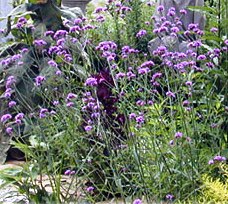Discover Florida Nature
It's time to explore the natural Florida


|
|
|
|
|
Browse through our alphabetical list of native Florida plants that
encourage butterflies into your garden, and find the perfect choices for
your Florida butterfly garden! Plants that have an asterisk beside their
name are especially high in nectar. Purpletop
Verbena
(Verbena spp)*- Purpletop verbena is an erect, clump-forming perennial
with stiff, widely branched stems. It can reach 3-6 feet in height with
an open, airy spread of 1-3 feet. The sandpapery stems and branches
grow in an upright pattern and are square in cross section. Most of the
leaves are clustered in a mounded rosette at the base of the plant. The
relatively scarce stem leaves are opposite, 3-5 inches long and clasping
(i.e. the leaves have no petioles and their bases wrap around the
stem). The Verbena flowers are purple, a quarter-inch across, and born
in rounded clusters about 2-3 inches across. Botanists call this type of
inflorescence a cyme: a flower cluster in which the center flower
opens first, and later-opening flowers are on the ends of lateral
branches that arise from below the first flower. Purpletop verbena
displays its showy flowers all summer long, until the first frost of
autumn. Purpletop
Verbena
(Verbena spp)*- Purpletop verbena is an erect, clump-forming perennial
with stiff, widely branched stems. It can reach 3-6 feet in height with
an open, airy spread of 1-3 feet. The sandpapery stems and branches
grow in an upright pattern and are square in cross section. Most of the
leaves are clustered in a mounded rosette at the base of the plant. The
relatively scarce stem leaves are opposite, 3-5 inches long and clasping
(i.e. the leaves have no petioles and their bases wrap around the
stem). The Verbena flowers are purple, a quarter-inch across, and born
in rounded clusters about 2-3 inches across. Botanists call this type of
inflorescence a cyme: a flower cluster in which the center flower
opens first, and later-opening flowers are on the ends of lateral
branches that arise from below the first flower. Purpletop verbena
displays its showy flowers all summer long, until the first frost of
autumn. Viburnum
(Viburnum spp)- Besides having attractive foliage and growth
habits, the best viburnums also offer lovely, sometimes even fragrant,
flowers. Many also boast colorful fruits and stunning fall foliage. In
addition, the fruits are appealing to birds and other wildlife. Viburnum
is native to Florida, but their range extends to South America. They are
admired for their foliage, flowers, and fruit. Most viburnums flower in
spring. The sometimes-fragrant flowers range from white and cream to
pink-flushed or wholly pink. They are born in terminal or axillary
panicles, clusters, corymbs, or cymes, which are often spherical or
domed. Some species have blooms similar to the flattened heads of
lacecap hydrangeas. Viburnums are usually shrubs, but their habits vary.
Viburnums excel as specimen plants or as anchors in mixed borders. You
won't find a more versatile group of shrubs for hedges or for massing in
groups, since viburnums hold their own in every season. Viburnum
(Viburnum spp)- Besides having attractive foliage and growth
habits, the best viburnums also offer lovely, sometimes even fragrant,
flowers. Many also boast colorful fruits and stunning fall foliage. In
addition, the fruits are appealing to birds and other wildlife. Viburnum
is native to Florida, but their range extends to South America. They are
admired for their foliage, flowers, and fruit. Most viburnums flower in
spring. The sometimes-fragrant flowers range from white and cream to
pink-flushed or wholly pink. They are born in terminal or axillary
panicles, clusters, corymbs, or cymes, which are often spherical or
domed. Some species have blooms similar to the flattened heads of
lacecap hydrangeas. Viburnums are usually shrubs, but their habits vary.
Viburnums excel as specimen plants or as anchors in mixed borders. You
won't find a more versatile group of shrubs for hedges or for massing in
groups, since viburnums hold their own in every season. |
|
|
Advertise | Privacy Statement | Contact | Alaska Nature | Michael Arnold Art| Dog Encyclopedia | Dog Encyclopedia| |
|